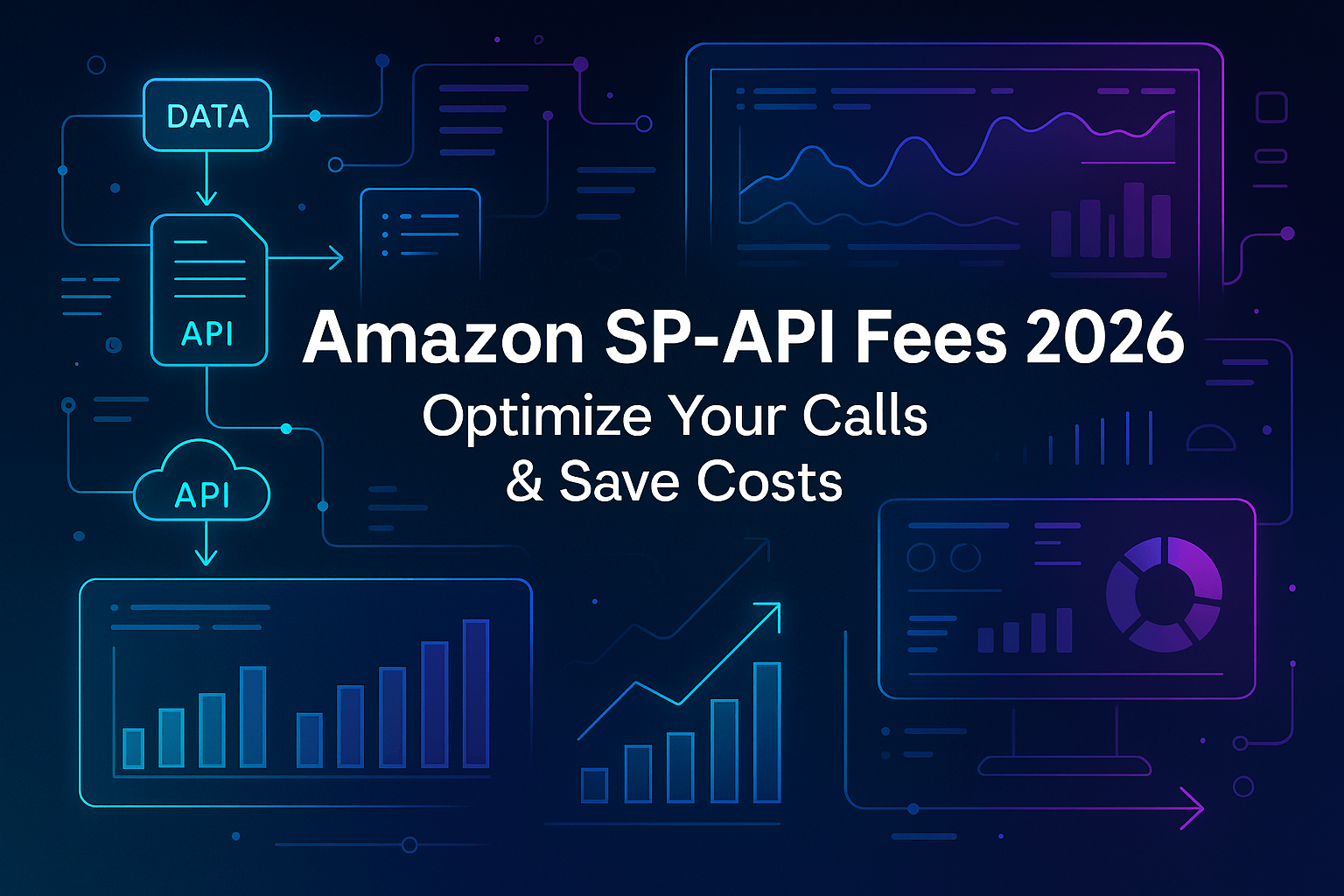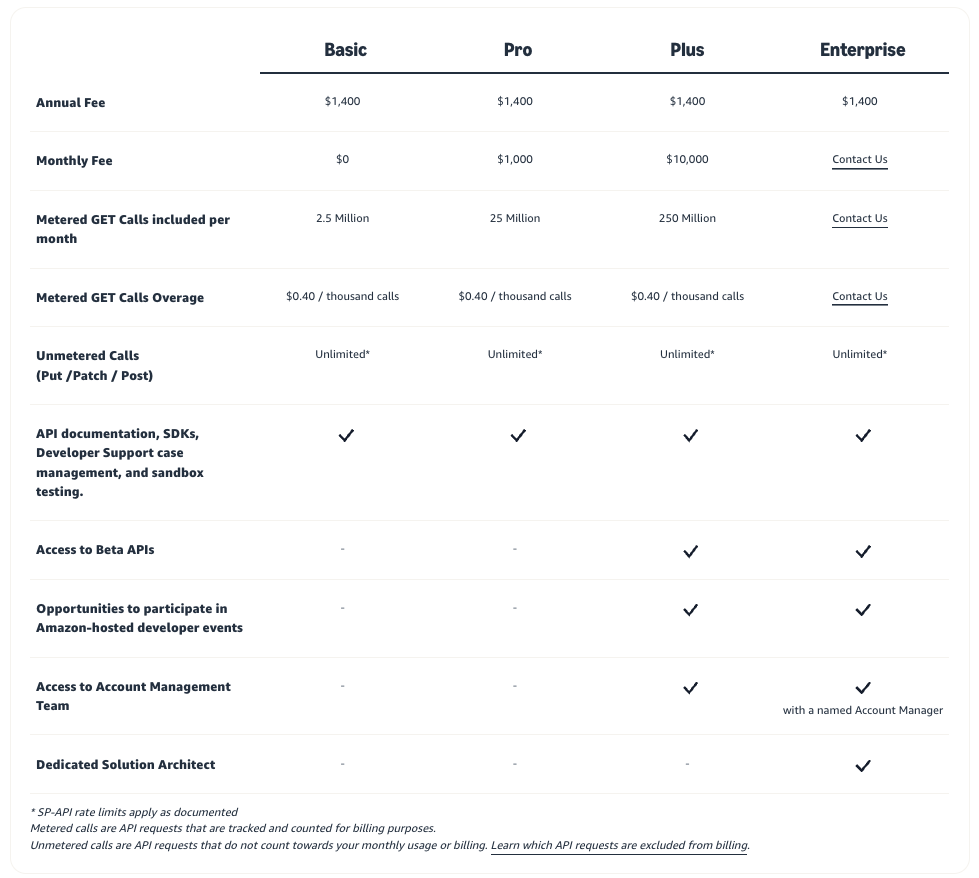Amazon SP-API 2026 Fees: How to Optimize Your API Calls and Save Money

Amazon SP-API Fees Are Coming: What They Mean & How to Optimize Your API Usage
Amazon has officially announced a major change to its SP-API pricing model - and if you’re a developer, agency or tool provider working with Amazon sellers, you need to read this. These changes have real cost implications. But with smart design and architecture, you can materially reduce your risk and increase your margin.
What’s Changing in SP-API Fees
Here are the key take-aways from Amazon’s announcement: developer.amazonservices.com
- Starting January 31, 2026, every third-party developer (i.e., apps offered to other selling partners) will be charged a $1,400 USD annual subscription for SP-API access.
- From April 30, 2026, monthly usage-based fees apply for GET API calls beyond the included tier.
- The default “Basic” tier includes 2.5 million GET calls/month at no additional charge beyond the subscription.
- Overage of GET calls beyond the included amount is charged at $0.40 USD per 1,000 calls.
- Sellers and vendors who use SP-API strictly for their own business (private apps) will not incur these new third-party developer fees.
- Key dates:
- Billing setup opens Nov 3 2025
- Payment & tax info must be submitted Jan 31 2026
- Applications without valid payment by Feb 16 2026 risk losing access.

Why This Matters
If you manage multiple Amazon seller accounts, run an agency, or develop tools used by many sellers, your GET call volume is a direct cost factor now. Unoptimized APIs = high fees. Optimized APIs = competitive edge + lower cost base.
How to Optimize Your SP-API Usage (and Save)
We at Deltologic have built and optimized dozens of SP-API integrations. Here are our top techniques to slash GET-call volume and future-proof your architecture.
1. Replace Reports Polling with Event-Driven Notifications
Old way: You create a report (POST) and then poll the Reports endpoint repeatedly (GET) to check status. This often results in tens or hundreds of GET calls per report.
Better way: Subscribe to the REPORT_PROCESSING_FINISHED notification via the Notifications API. Amazon sends you an SQS message when the report is done (status: DONE, CANCELLED, FATAL) so you only call getReport once.
Upside: Drastically fewer GET requests.
Trade-off: Slightly more complex setup. Works best with production environment (less so in local dev).
Bonus link: Video walkthrough on setting this up: https://www.youtube.com/watch?v=6YU4SoZED3w
2. Use Reports Instead of GET Orders for Bulk Data
If you’re pulling large sets of orders, don’t fire repeated getOrders or getOrder calls. Instead use Order-type Reports (see Amazon docs for report type values). When combined with notifications, you can get thousands of orders in one operation.
Upside: Massive reduction in GET operations.
Trade-off: Some fields may not be included in the report (e.g., customised orders ZIP). Validate your use case.
Also consider using the ORDER_CHANGE notification instead of polling getOrders to detect new/updated orders.
3. Listings & Inventory: Same Logic
Instead of repeatedly calling getListings or getInventory, use the appropriate Listings or Inventory Reports + the corresponding notification for when data is ready/changed. Fewer GETs, more efficiency.
4. Catalog Items: Fetch in Bulk
Rather than getCatalogItem one-by-one, use searchCatalogItems which allows up to 20 catalog items per request and a higher rate limit (40 items/sec vs 2 items/sec).
Result: Many fewer API calls, no downside.
Summary of Benefits
By adopting these optimizations you can:
- Reduce GET API call volume by 80-90% or more
- Lower your future SP-API usage fees
- Improve speed, efficiency and reliability of your integrations
- Gain a competitive cost advantage over other developers/tools
How Deltologic Can Help
At Deltologic we specialize in building custom software, dashboards and ETL/data connectors for Amazon sellers, vendors and agencies. We’ve helped clients reduce API load, optimize architecture, and prepare for Amazon’s new SP-API fee model.
If you’re concerned about the new fees, or want to audit your current implementation, we can help you:
- Identify redundant or excessive API calls
- Re-architect to use notifications + reports instead of polling
- Set up usage dashboards & alerting
- Build optimized integrations to scale profitably
Contact us at deltologic.com to schedule a consultation.





.webp)


